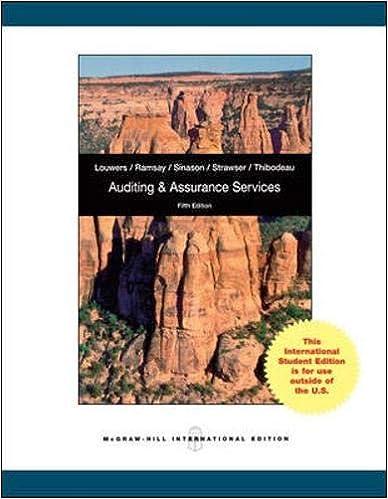Answered step by step
Verified Expert Solution
Question
1 Approved Answer
KPMG provided a preliminary draft of the integrated audit reports for Devonshire, Inc., to Charles Knight, CPA and CFO. After reading the draft, Charles was
KPMG provided a preliminary draft of the integrated audit reports for Devonshire, Inc., to Charles Knight, CPA and CFO. After reading the draft, Charles was pleased to see that KPMG had given the company a clean audit opinion on the financial statements. He was dismayed, however, to learn that they had concluded and were planning to issue an adverse opinion on internal control over financial reporting as a result of a material weakness. Charles was concerned that the adverse opinion might result in a large drop in the market price of the company's stock. Included with the draft of the report was the following note of explanation from Adam Fernley, the partner in charge of the engagement, as to how KPMG had reached this conclusion:
Dear Charles,
As you know, we perform an integrated audit that combines our audit of the financial statements with an audit of internal controls over financial reporting. Unfortunately, as we conducted our work, we discovered a series of control deficiencies, which individually are not material. Taken together, we believe these deficiencies represent a more than remote likelihood that a material misstatement could occur and not be prevented or detected and constitute a material weakness. Therefore, an adverse opinion on internal control over financial reporting has been rendered. We are also concerned that other internal control weaknesses could provide indirect evidence raising concerns about managerial ability because the design and implementation of internal controls is a primary management responsibility.
After you have had a chance to review, please feel free to reach out to me to discuss.
Identified weaknesses:
We found inadequate segregation of duties over access to your sales information system controls.
We found several instances of transactions in the general ledger that were not also recorded in the appropriate subsidiary ledger: these transactions were not material individually or in aggregate.
We found that timely reconciliations of certain intercompany accounts were not being performed. The intercompany transactions were material on an individual basis and only impacted balance sheet accounts.
We found insufficient procedures to qualitatively assess whether the fair value of a reporting unit is less than its carrying value in order to assess goodwill impairment.
Charles immediately shot off an email to the partner requesting a meeting stating that he vehemently disagreed with his analysis. He further stated that he thought KPMG was intentionally misclassifying these items as a material weakness over fear of potential legal liability.
In your initial post, address the following questions:
What are the main arguments that Adam will need to counter when he meets with Charles? That is what are the reasons and rationalizations he should expect to hear from Charles about why a material weakness in the ICFR does not exist?
What is at stake for both Charles and KPMG should Adam be unable to convince Charles to accept the material weakness disclosure? Explain.
What resources are available to Adam to support the position taken? Will Adam be able to provide Charles with definitive proof of appropriateness of the material weakness classification?
Step by Step Solution
There are 3 Steps involved in it
Step: 1

Get Instant Access to Expert-Tailored Solutions
See step-by-step solutions with expert insights and AI powered tools for academic success
Step: 2

Step: 3

Ace Your Homework with AI
Get the answers you need in no time with our AI-driven, step-by-step assistance
Get Started


